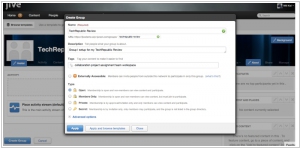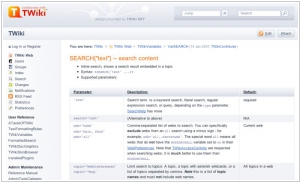Jive vs TWiki
March 20, 2025 | Author: Adam Levine
3★
Jive’s enterprise social networking platform allows you to engage employees, customers, and the social web. Increase the efficiency of internal communication, build brand loyalty, and monitor customer chatter and ideas, all from one central location. Say good bye to your intranet, multiple logins for scattered enterprise apps, and being out of the loop; the Jive Engage platform integrates the social networking tools you love and need so you can focus on what matters.
2★
TWiki is a flexible, powerful, and easy to use enterprise wiki, enterprise collaboration platform, and web application platform. It is a Structured Wiki, typically used to run a project development space, a document management system, a knowledge base, or any other groupware tool, on an intranet, extranet or the Internet.
Jive and TWiki are, at first glance, two remarkably similar things: both help people organize knowledge, collaborate and generally pretend they have a grip on the ever-expanding chaos of enterprise information. They allow users to create, edit and share content while maintaining a sense of order through permissions and access controls, which is, of course, a bit like trying to herd cats with a well-worded memo. Both also support plugins because no matter how much functionality you build in, someone always wants a button that does something strangely specific, like automatically congratulating Bob in accounting every time he updates a spreadsheet.
Jive, a proud creation of an American company that thought "Jive" was an excellent name for a serious enterprise tool, launched in 2001 with a focus on social networking for the corporate world. It features delightful modern distractions like activity streams, gamification and an interface designed to make employees feel like they’re scrolling through social media instead of working. Mobile-friendly and slick, it aims to keep users engaged or at least convincingly pretending to be.
TWiki, on the other hand, emerged from Switzerland in 1998 with a more austere, wiki-based approach, where structure, version control and an unspoken expectation that users enjoy writing scripts are the order of the day. It lacks the friendly social features of Jive, possibly because it assumes its users prefer text to people and that’s just fine. It is endlessly customizable, which means that with enough effort, it can do almost anything—though by the time you’ve configured it to do so, the original need for it may have long since disappeared.
See also: Top 10 Wiki software
Jive, a proud creation of an American company that thought "Jive" was an excellent name for a serious enterprise tool, launched in 2001 with a focus on social networking for the corporate world. It features delightful modern distractions like activity streams, gamification and an interface designed to make employees feel like they’re scrolling through social media instead of working. Mobile-friendly and slick, it aims to keep users engaged or at least convincingly pretending to be.
TWiki, on the other hand, emerged from Switzerland in 1998 with a more austere, wiki-based approach, where structure, version control and an unspoken expectation that users enjoy writing scripts are the order of the day. It lacks the friendly social features of Jive, possibly because it assumes its users prefer text to people and that’s just fine. It is endlessly customizable, which means that with enough effort, it can do almost anything—though by the time you’ve configured it to do so, the original need for it may have long since disappeared.
See also: Top 10 Wiki software




